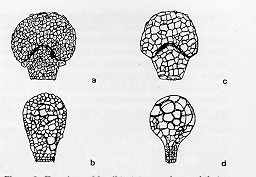
compressa but is somewhat smaller (Ogden and Hedley, 1980). In either case, this fossil would be the oldest fossil representative of the genus; "Pontigulasia" was previously known only as far back as the Miocene (Loeblich and Tappan, 1964).
Class Filosea
Order Gromiida
Suborder Euglyphina
Family Nebelidae
Genus cf. Nebela Leidy, 1874
Figures 2d, 5-6
Material: UCMP type 39887. One test.
Description: Transparent pyriform test 32.5 mm long, with elongated neck (33% of total length), constructed of plates interspersed with granular and irregular elements. A central optical plane shows what appears to be a thick wall; this is interpreted as a peripheral flange extending all around the test. The aperture is extremely narrow.
While the test can be placed with confidence in the extant genus Nebela, it does not resemble extant species of Nebela very closely. In overall size and shape, perhaps its closest analogue is N. tubulata Brown 1911 (fig. 2b); this species, however, has no flange (Ogden and Hedley, 1980). The fossil may in fact represent a new species, but since only one specimen has been found so far, and since certain morphological details such as the flange and the aperture cannot be closely examined, no attempt will be made to identify it beyond the genus level.
Remarks: This is the oldest record of this genus; Nebela is otherwise known from Pleistocene to Recent time (Loeblich and Tappan, 1964).
Aside from a report of a foraminiferan in Eocene Baltic amber (Katinas, 1983), testate amoebae have been reported from late Triassic amber of Bavaria (Poinar et al., 1993a) and Eocene-Oligocene amber from the Dominican Republic (Waggoner, 1996). Outside of amber, this group of terrestrial protists is known from Carboniferous, Cretaceous, and Eocene to Recent sediments (Loeblich and Tappan, 1964; Schuster, 1990), but its fossil record is poor compared to other groups of microfossils. This may be due to the terrestrial habits and organic tests of many testate amoebae, conferring poor preservation potential, or to relative neglect by micropaleontologists. In modern terrestrial ecosystems, this group contributes to bacterial population control, nutrient cycling and mineralization, and litter

|
| Figure 2. Drawings of fossil testate amoebae and their living analogues. (a) Living Pontigulasia (after Bovee, 1985a). (b) Living Nebela (after Bovee, 1985b). (c) Fossil Pontigulasia. (d) Fossil Nebela. |
breakdown. Testate communities are excellent indicators of factors such as soil/litter type, organic matter levels, and environmental moisture (Bamforth, 1980). Amber has a high potential for extending the fossil record of this group.
Phylum Uncertain
Figures 8-10
Material: UCMP 39888, 39889, 39890.
Description: Rounded or ovoid bodies with distinctive orange color; apparent granular cytoplasm and nuclei. One specimen (fig. 9) shows traces of a nucleolus within the nucleus. Another (fig. 8) has a definite cell wall with a stalk or process attached to it.
Remarks: All that can be said about these fossils is that they are unicellular and may be protists, although an anonymous reviewer of an earlier draft of this paper suggested they might be fungal in origin. They do not necessarily represent the same organism. Compared with extant protists, these fossils are commensurate in size with many amoebae and smaller ciliates. They somewhat resemble the amoebas described from Triassic amber (Poinar et al., 1993b). The orange color is reminiscent of certain ciliates, notably Nassula (Lynn and Small, 1985), but the nucleolus inside the nucleus of one of the specimens rules out a ciliate affinity for that specimen. The specimen with the cell wall may be a cyst of some sort; many protists form resting cysts to resist unfavorable conditions. Without staining, no sound identification of these fossils can be made.
Contine to Page 23
© PaleoBios 1996